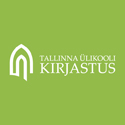Märkmeid Jaan Siirakust ja tema maalist „Verduni katedraal sõjapurustustes” [Notes on Jaan Siirak and his painting Verdun Cathedral after World War I]
Abstract
Jaan Siirak (Laatre, 1897–1959, Tallinn) was born in Sangaste parish, Estonia, and studied at the Penza Art School in central Russia. There he made friends with Estonians and Latvians, future constructivist artists, and appears to have joined the art group “Polar Bear”. The studies in Penza (1914–1918) were interrupted by the war and the Bolshevik coup d’etat. While in St Petersburg, trying to continue his work and education, Siirak is said to have led a Nordic artists’ community. After the collapse of the Russian Empire and the birth of the Estonian Republic, Siirak worked as a teacher of both art and the history of art in Tartu. From 1924 to 1932 he lived in Paris, working on civil construction and studying at the École des Arts et Métiers. From 1925 on, the artist took part in the foundation and activities of L’Association estonienne de Paris. The members organized exhibitions, meetings, conferences, lectures and publications introducing Estonian culture; related books were stored in cafés in Montparnasse. From 1924 to 1932, Siirak yearly participated in the exhibitions of the Société des Artistes Indépendants, receiving excellent reviews for his oil paintings and sculptures; his style was characterized as “Mouvementalism”. A single painting from that time has reached Estonia so far. It was found in poor condition in a shed and conserved at the Art Museum of Estonia. The work (1924), beginning in the 1980s, was displayed in permanent or temporary exhibitions as View of a town or Paris. Recently, the theme of the painting was discovered thanks to a photo postcard (1933), which was found in Riga. A view of an applied art exhibition can be seen in the postcard, with Siirak’s painting on a wall. In his note on the other side of the card, the artist characterizes the image as the ruins of the basilica in Verdun. So the title was changed to Verdun Cathedral after World War I. The old/new title evokes many associations. A cathedral was once a symbol of Divine Order, a religious and community centre, and a model of the (ideal) world. Verdun Cathedral was destroyed during one of the longest and most terrible batt les of World War I, in 1916. In Siirak’s painting, his impressions of diff erent ruined buildings are generalized, and diff erent tendencies in art are combined: Constructivism with a bit of Post-Expressionist dynamism, almost Piranesian fantasy, and the decorative smooth surfaces and small fi gures of elegant citizens of hedonistic Art Deco. Through the damage caused by the war, light penetrates: “God is light” (1 John 1:5), bringing hope. New (social) life emerges from the ruins of the past. Everything is monitored by a photographer in the foreground of the painting. Siirak’s talent mainly blossomed during the years we now call the inter-war period. He was hard-working and inventive, and had outstanding organizational skills. The legacy of Jaan Siirak, a sculptor, a painter, a book decorator, and an interior and furniture designer, deserves more thorough study and appreciation.
Keywords
World War I, Verdun Cathedral, modernist painting
Full Text:
PDFRefbacks
- There are currently no refbacks.
Published by / Kirjastaja:

ISSN 2504-6616 (print/trükis)
ISSN 2504-6624 (online/võrguväljaanne)
